Recently, Jean-Claude Biver announced that Zenith’s Aldo Magada had resigned. Magada had been president and CEO of the Le Locle-based brand for two years and seven months.
Biver is set to take over this post in the interim, adding Zenith to his workload as CEO of TAG Heuer and chairman of LVMH’s watch division. I describe the last LVMH rearrangement – including the big changes at Zenith in 2014 – in Jean-Claude Biver Restructures LVMH Watch Brands; TAG Heuer CEO Stéphane Linder Resigns. Coincidence?
It’s not an enormous industry secret that Zenith has been flailing somewhat since its takeover by LVMH in 1999 and the ensuing reign of then-CEO Thierry Nataf, which heralded in the eyes of many an unfortunate turn of both direction and fortune for the Swiss chronograph legend.
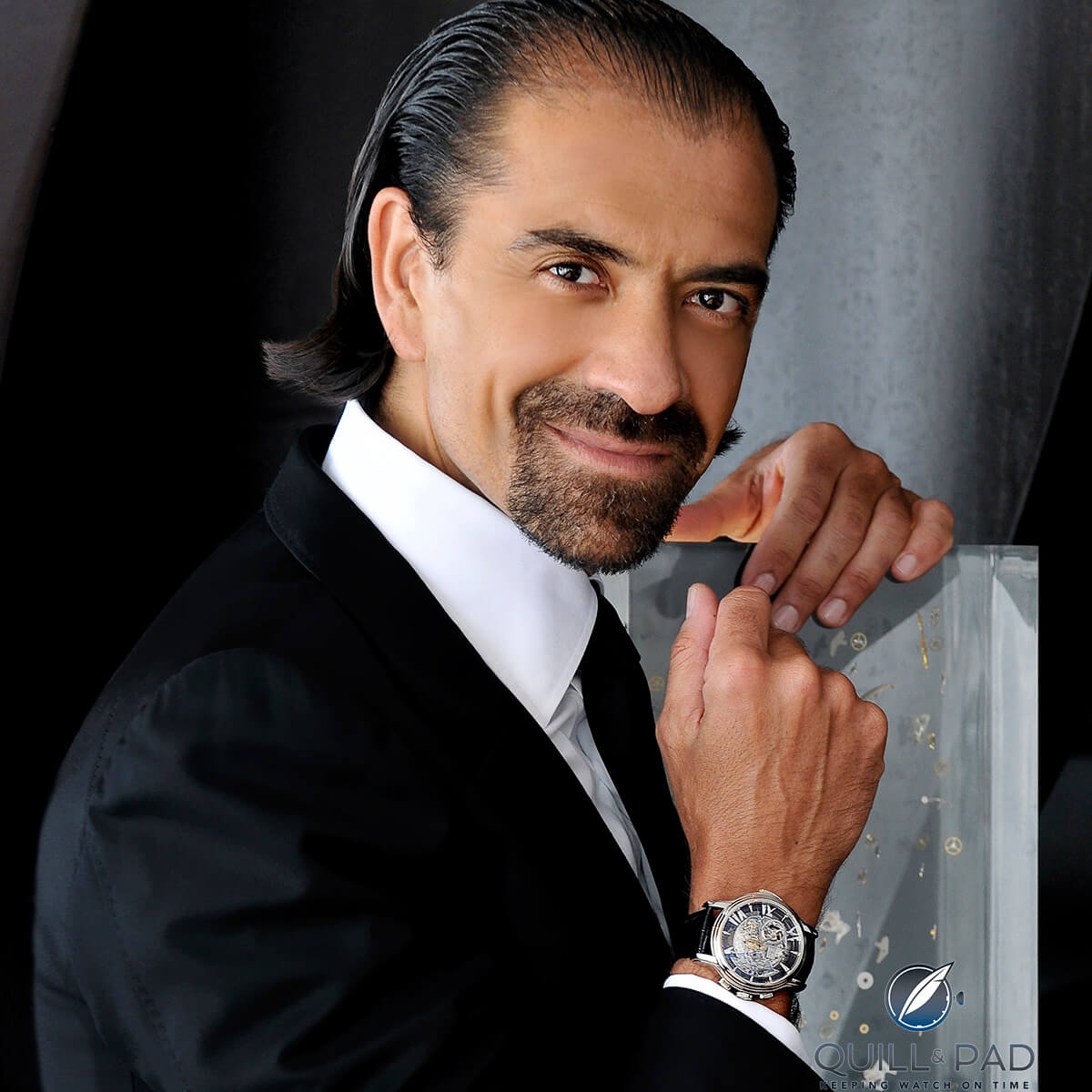
Former Zenith CEO Thierry Nataf wearing the Academy Repetition Minutes
Nataf, a flamboyant personality, took it upon himself to “transform” Zenith from an insider’s secret of sorts, with fair prices and classic good looks powered by in-house movements like the Elite and the El Primero, to an early example of 2000s “monster” watchmaking, culminating in the Defy Xtreme Zero-G, a blackened titanium-encased monstrosity that had little to do with the brand’s historical golden thread. It sold for $545,930 in 2008 when it was introduced.
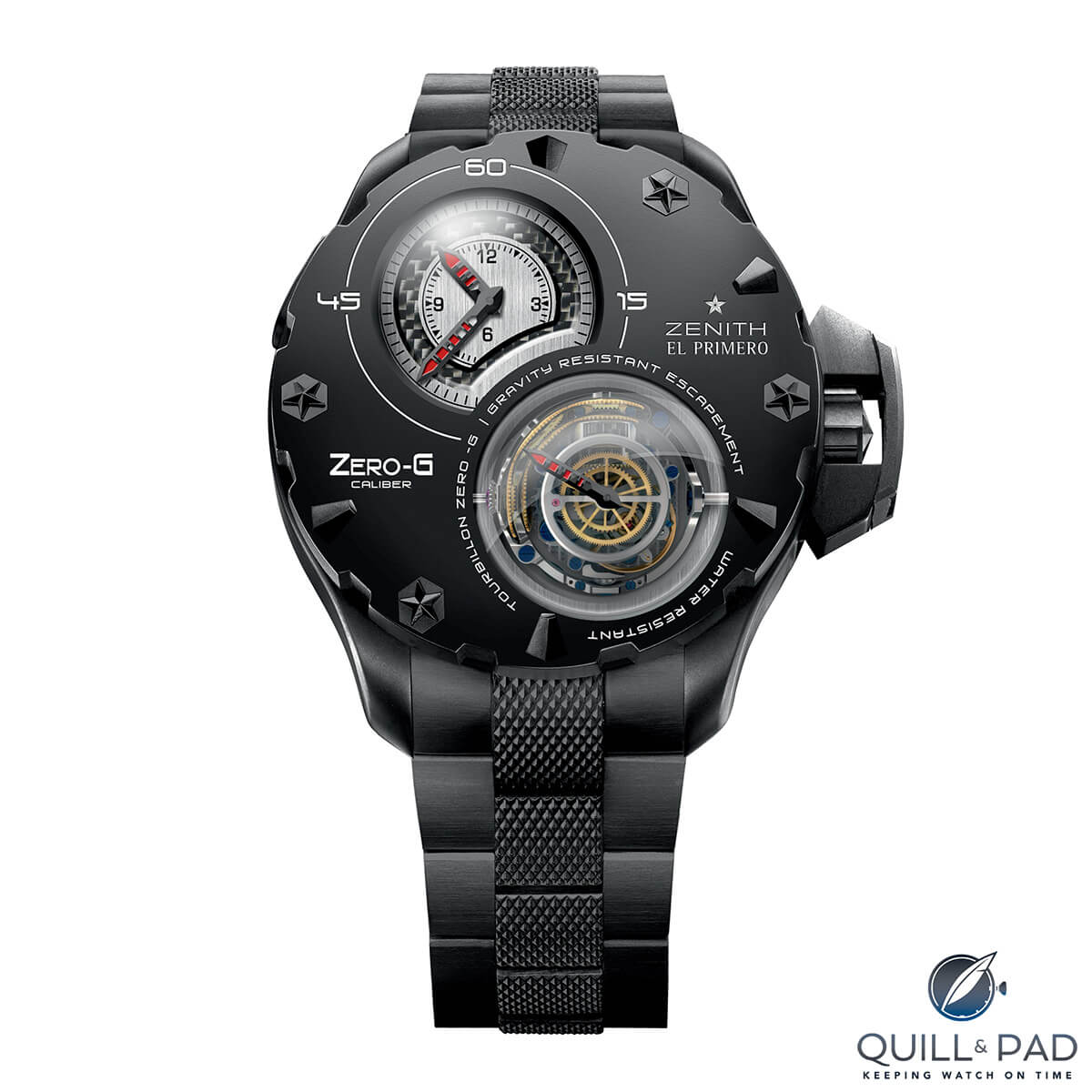
Zenith Defy Xtreme Zero-G from 2008
The Defy Xtreme Zero-G was to be Nataf’s swan song, and more than a few avid fans of traditional watchmaking were not saddened by his departure.
After a short period of seeming stability under Jean-Frédéric Dufour, who successfully endeavored to bring the brand back to its illustrious classically inclined roots, the brand went back into disarray mode in 2014, when Dufour left to lead Rolex as CEO and was replaced by Aldo Magada. Magada and his team were not able to bring Zenith back to its former glory in terms of reputation and product.
And we’re not saying this is necessarily any recent CEO’s fault as there are certainly a lot of hands in the background pulling the strings at Zenith. We’re just stating the facts as we see them.
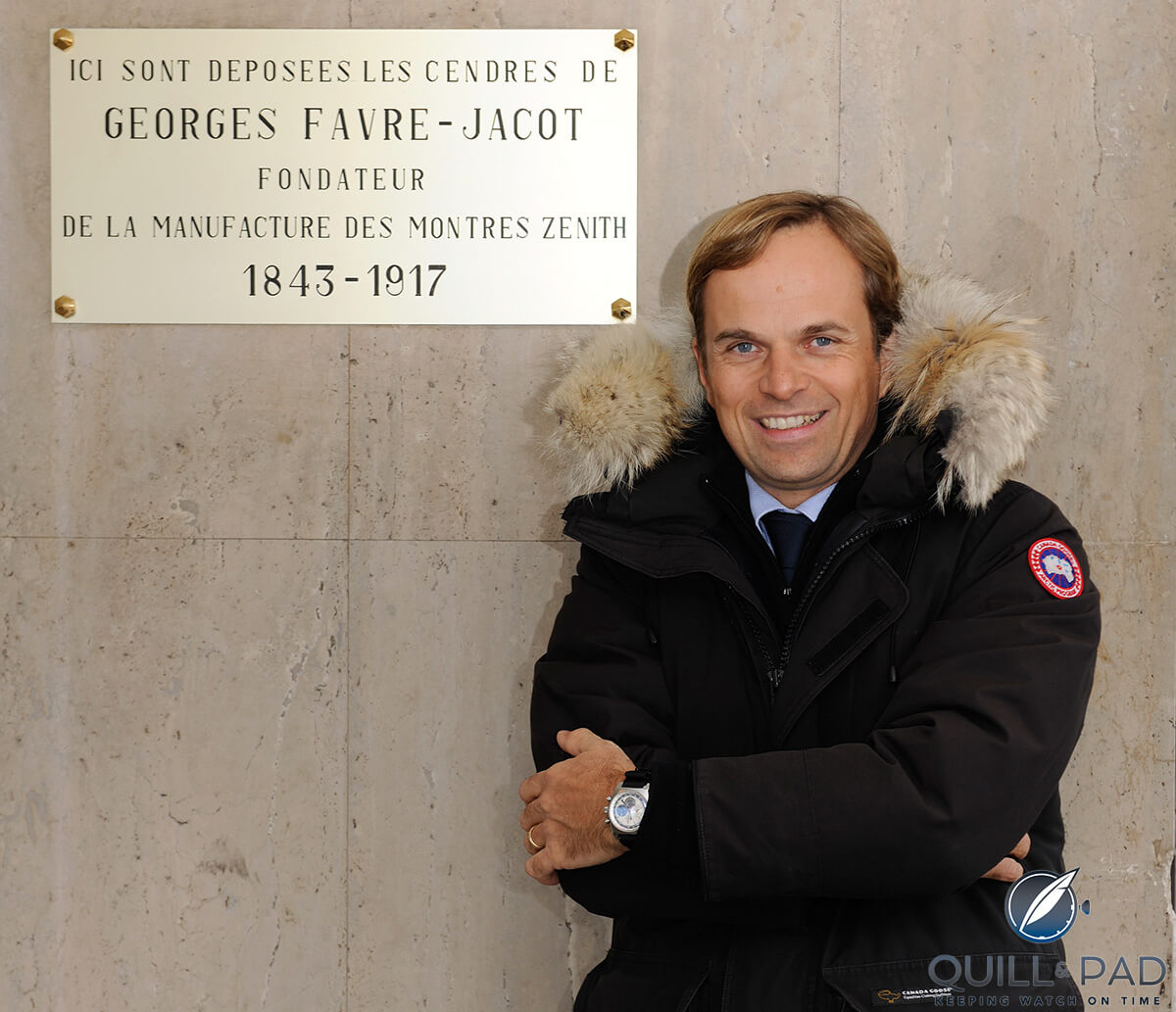
Jean-Frédéric Dufour during his time as Zenith CEO
So, to aid the as-yet nameless incoming CEO with a bit of gratuitous advice (whether wanted or not) we offer a classic Quill & Pad round table discussion on what we would do if one of us were named the new CEO of Zenith tomorrow.
#makezenithgreatagain
Our participants are:
IS Ian Skellern, co-founder of Quill & Pad
ED Elizabeth Doerr, co-founder of Quill & Pad
JM Joshua Munchow, resident nerd at Quill & Pad
GG GaryG, resident collector at Quill & Pad
WMMT What Makes Me Tick, resident storyteller and opinionator at Quill & Pad
RS Ryan Schmidt, Quill & Pad contributor and author of The Wristwatch Handbook
MG Martin Green, resident gentleman at Quill & Pad
IS: What would I do if parachuted in as the new CEO of Zenith?
Spoiler alert: doom and gloom follow!
I am pessimistic for high-end mechanical watch brands in both the short and medium term, and that’s independent of whether the world economy picks up this year or not. I feel that in the quest for ever-increasing profits the larger brands have, and still are, making far more watches than the market can support.
There are and will be a few particularly well managed or just plain lucky brands that will do well, but they will be the exceptions.
Even if things pick up economically, and consumers worldwide grow in both wealth and number, I expect the large brands to do what they have done for the last 20 years: produce too much and continue the boom-bust cycle. That puts pressure on medium-sized brands like Zenith, whose investor (LVMH) is unlikely to be brave enough to keep pouring money into what is likely to look like a bottomless pit.
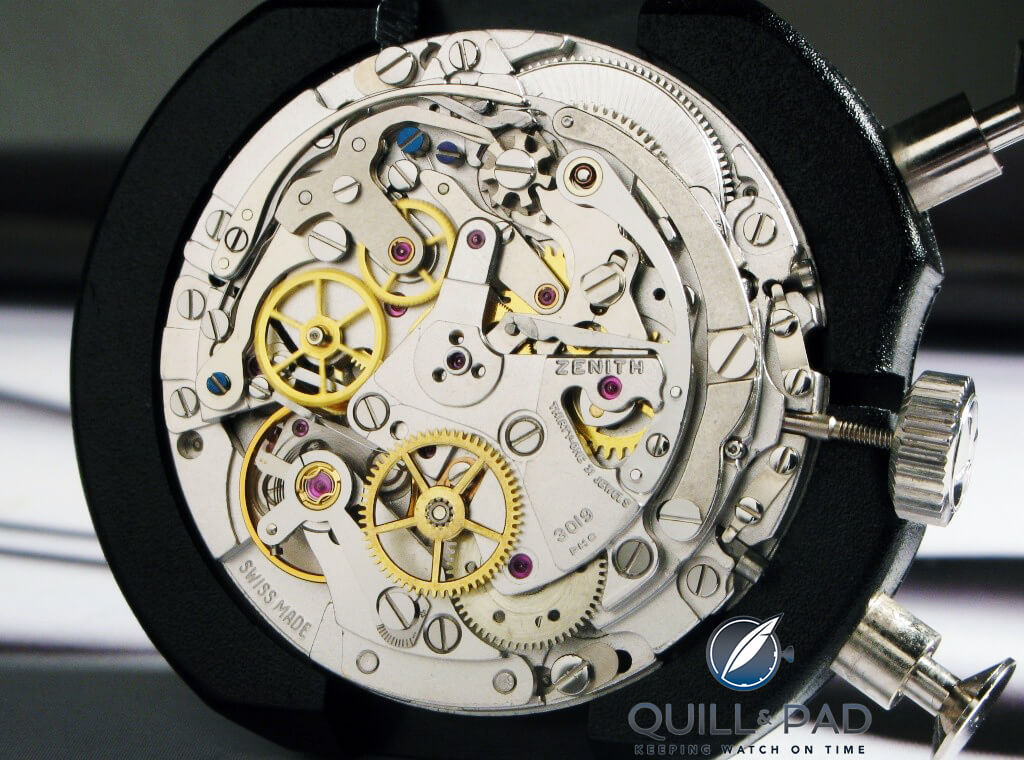
El Primero movement from 1969
Zenith design choices / styles / collections
RS: Zenith has 24 different types of El Primero watches and 20 Heritage models, not including dial/strap/case material variations. There are a more respectable 10 and 11 watches in the Academy and Elite lines respectively, but there are too many watches here altogether.
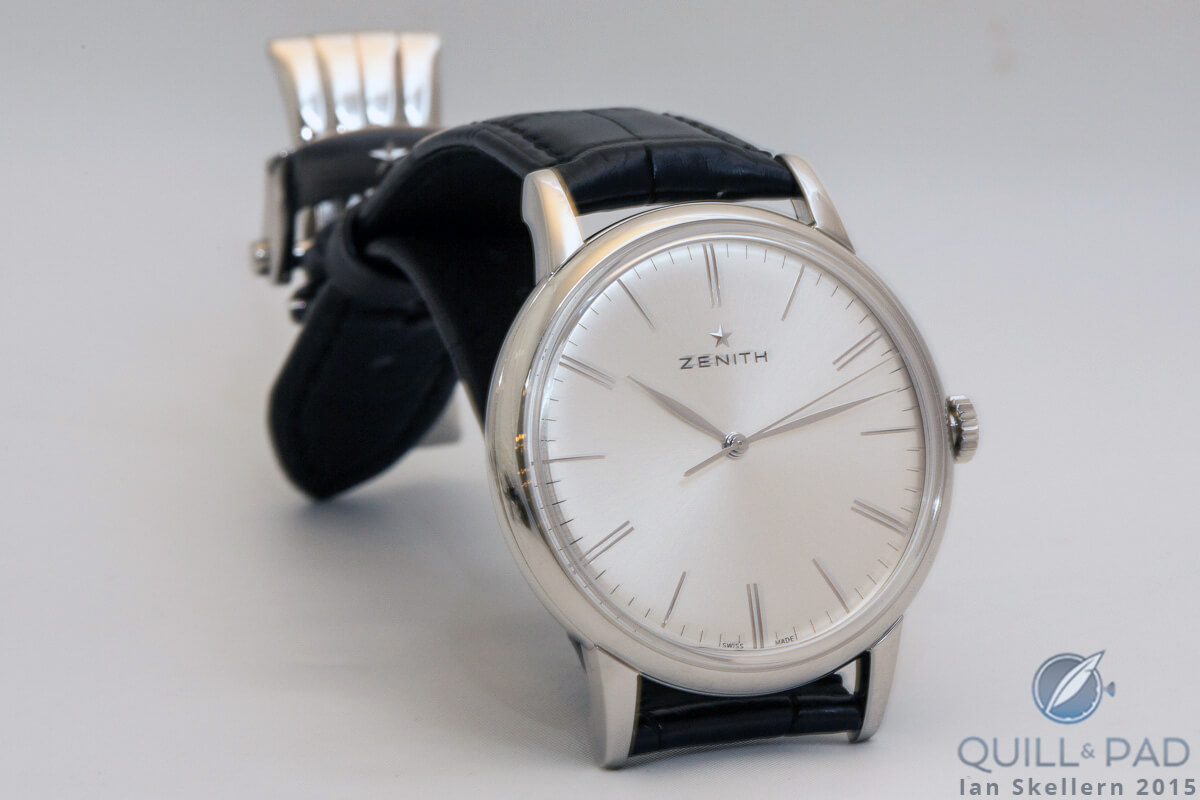
The elegant Zenith Elite of 2015
As new CEO, I would run a complete portfolio rationalization with five lines: El Primero, Pilot, Academy, Elite, and a new line for ladies’ watches headlined by a proper ladies’ watch (in other words not one outfitted with a mother-of-pearl dial or a heart-shaped aperture on a small men’s watch).
Each line would be capped at ten models per line; if we can’t satisfy the needs of our customers with 50 different models, we can’t satisfy them. That said, I would invest in strap variations and quick change mechanisms.
ED: Hallelujah, Ryan! Rationalization and taking female consumers seriously would be the very first steps I, too, would take in terms of collection optimization should I ever be called upon to take the reins of this historical brand. Quick-change straps are something every luxury brand should be offering by now, too.
MG: Good thoughts, Ryan. But profitability is an important aspect, especially since Zenith is part of LVMH. Steps need to be taken to ensure profitability, yet at the same time, it cannot be a quick fix. The brand’s “DNA” needs to be respected, because that is what sets it apart from the competition.
I’d be more radical than you, Ryan. I would pare the number of Zenith’s lines down to two: Elite and El Primero. Both are legendary watch models, though the Elite could use a bit more spotlight.
Each of these two collections would have three sub-collections: the first dedicated to the past, highlighting vintage versions of the El Primero as well as time-only watches now fitted with Elite movements. The second sub-collection would be a modern line with designs for today’s world, containing fewer models than there are now because focus is important.
Although the brand has created some wonderful variations on the El Primero movement in particular, what is missing is the next step. That is where the third sub-collection comes into play: a line of limited edition prototypes representing the next phase of both the Elite and the El Primero lines.
This would be the first time that a watch brand tests its new watches and movements on paying customers. These customers would receive watches to keep, outfitted with newly developed movements in a design that sets them apart.
Of course, these watches will already have gone through internal testing, but the customers would be involved in real-life testing as their watches would come with a special winder that records the watch’s “vital signs” at night, sending the data to Zenith.
These people would also be further involved in the development of the movement in the regular collection. This would not only set Zenith apart from other Swiss brands, it would also enhance the next step in the evolution of two legendary movements.
GG: To me, three potential avenues present themselves, each of which has some precedent in the current product line. Zenith could choose to go “hard tribute” with a steady stream of vintage recreations and homage pieces like the Pilot Ton Up.
Or it could take off from the Rolling Stones El Primero as a starting point and try to run the same sort of celebrity/co-branding play already in full force at Hublot and TAG Heuer (see Zenith Launches Limited Series Of Rolling Stones Timepieces).
ED: Looking at Biver’s recent plays, Gary, I would say that that is probably the direction Zenith is already in the starting blocks to head down. And, to be fair, he has had success with these strategies. But despite TAG Heuer’s success with it, I do hear grumblings from the brand’s “old” consumers and industry watchers as to whether that is a good long-term strategy, not just good for the short term. It will be interesting to see how this continues to play out.
For Hublot, it has worked like magic – and so it should if implemented well and without fear. Hublot was a “new” brand with hardly any previous associations; this gave it purpose, real (hopefully lasting) life, and a world stage.
I’m not sure consumers would accept the same strategy at Zenith, which already has an age-old personality and niche. I do think working the already-established niche as well as Biver works his other business models would do the trick, though.
GG: In that case, it could attempt a refresh/re-launch along the lines of the successful Tudor revival using the modern-but-recognizable form evident in the Range Rover special edition El Primero as the base.
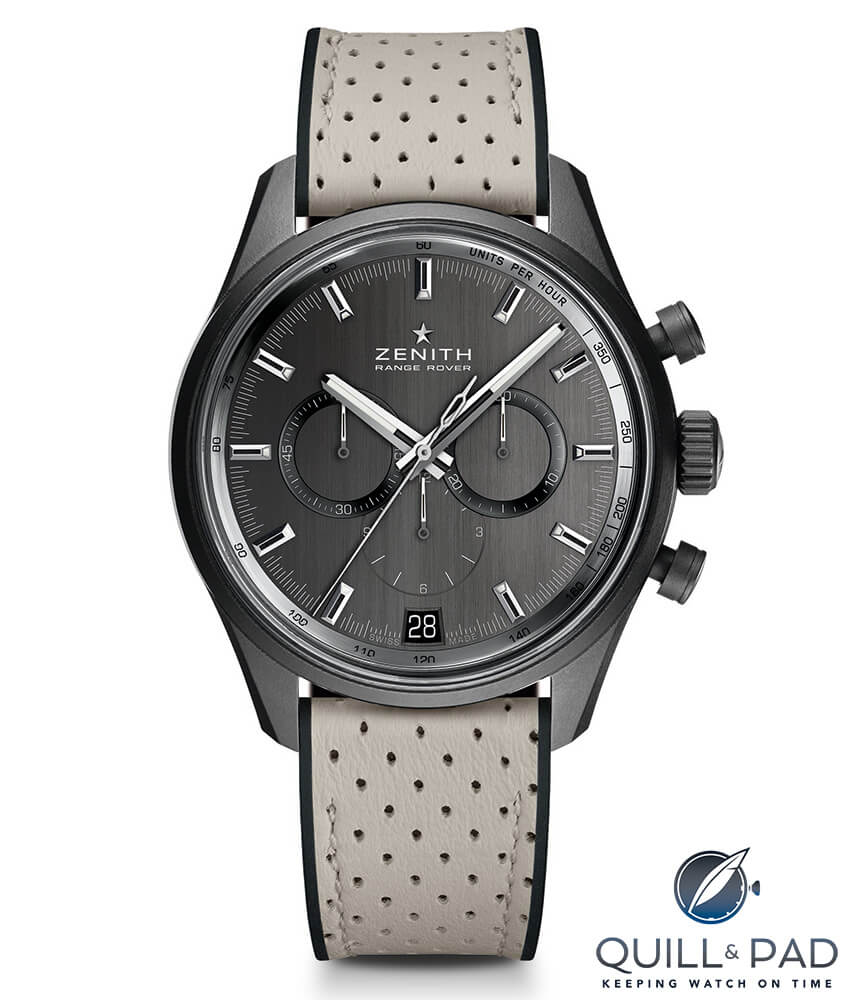
Zenith El Primero Range Rover Special Edition, launched in September 2016 ($7,700)
The thing is, the brand can’t do all three of these suggestions at once; and in addition to picking a core direction it will also need some significant product line paring regardless of which vector is pursued.
If I had to pick one of the three potentially viable plays based on my modest review of the situation, I’d go for the “Tudor alternative” as Omega seems to have abandoned that position to move upmarket versus Rolex. My second pick would be the vintage/tribute avenue.
I do hope that it doesn’t decide simply to “Hublot” itself, either: it’s one thing to decide to go the “lifestyle brand” route, but another to find the right mix of product, promotion, and brand positioning to make it work.
That said, as a betting man I’d place highest probability on Biver steering the Good Ship Zenith in that direction – so I agree with you, Elizabeth.
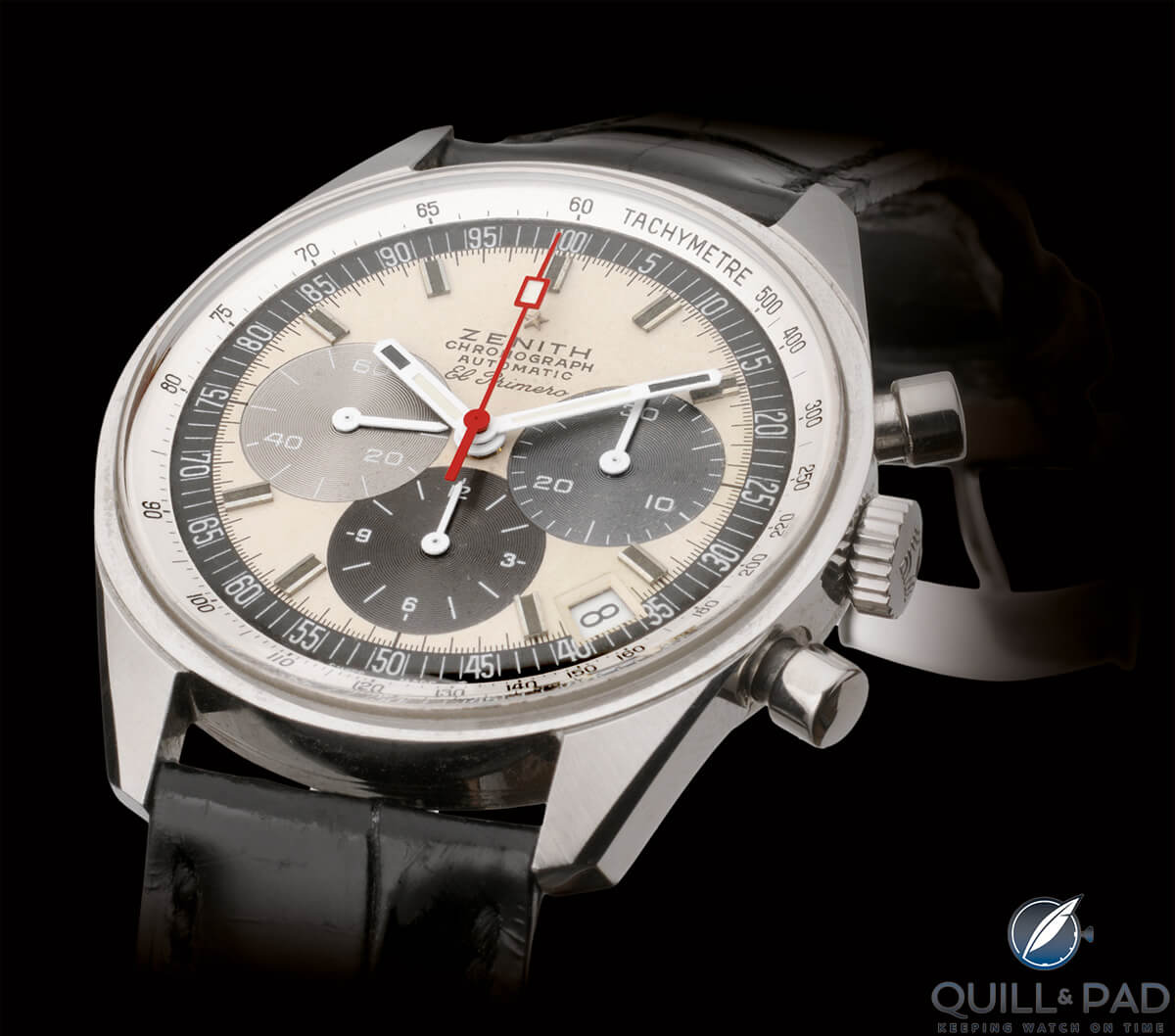
Zenith El Primero from 1969
WMMT: If I were CEO of Zenith, I would certainly stop cutting up the dials to show the El Primero movement, which is butt ugly. I would also try to remember that Zenith was more than 100 years old when the El Primero was launched, so I would go back a bit further than 1969 for main design cues.
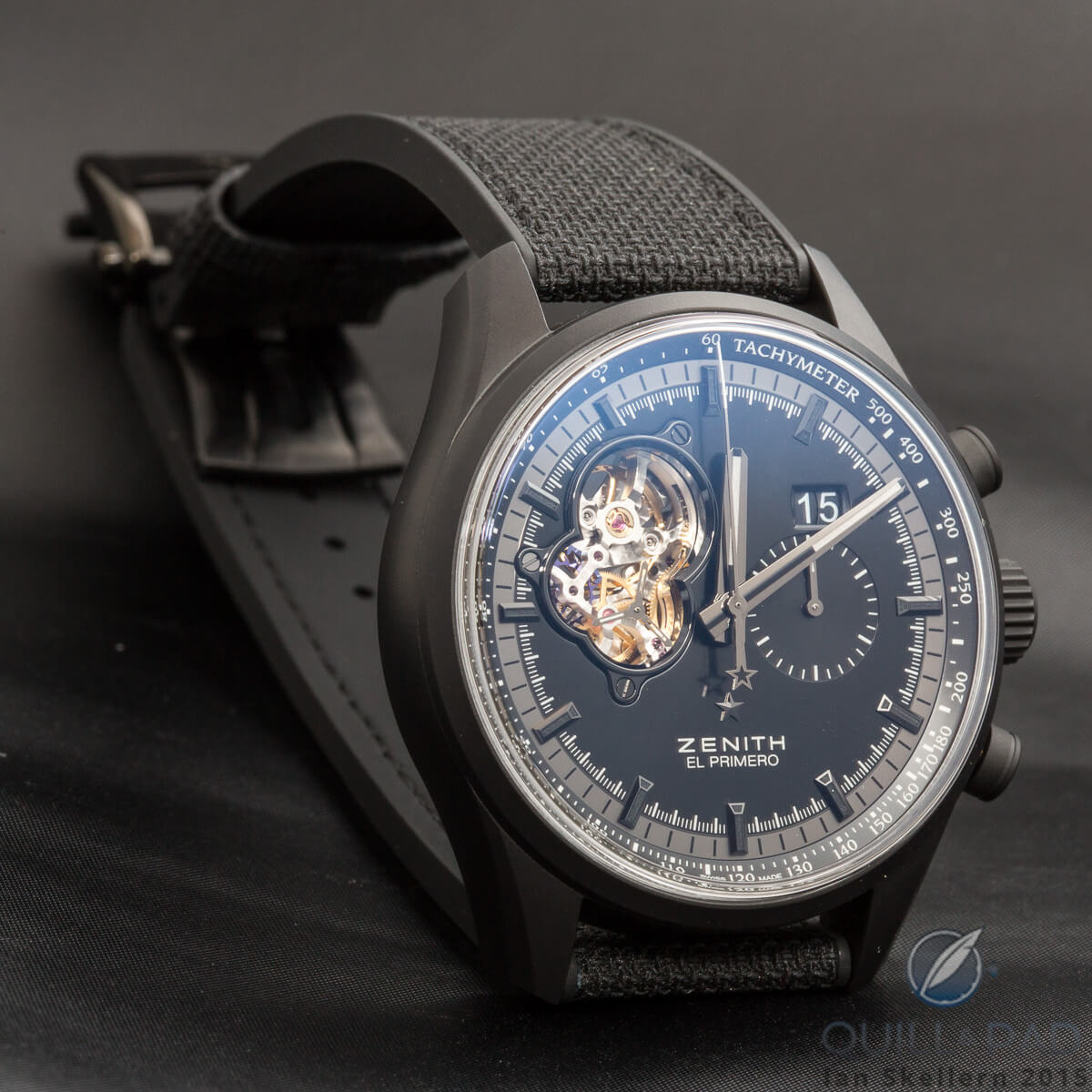
A Zenith El Primero variation with dial cutaway from Baselworld 2015
RS: In terms of openworked dials and large apertures, the game has changed over the last ten years. I do appreciate those silicon escape wheels and levers, but they eclipse the rest of the view. If I were CEO, there would be a new rule: if you are showing the movement on the dial you need chamfered edges, unique wheel spokes, and more than perlage on the bridges.
GG: Or to formulate that a bit differently, gentlemen, two strategies should be off the table altogether: the first being a “fine watchmaking halo” approach that would include more pieces like the Academy Christophe Colomb Hurricane Grand Voyage II, and the second being the apparent current momentum strategy of introducing a steady stream of slightly warmed-over El Primero variants each season.
JM: Oh, I would totally drop Christopher Columbus as a naming and design feature on Zenith watches, Gary. The world knows his legacy isn’t what it used to seem and there are plenty of other historical figures that should be honored first.
IS: I see only two (profitable) strategies for Zenith as a watch brand:
1. Abandon all hope of growing; write off most of the value and investment in the company; and shrink to a profitable niche brand making low numbers of superlative El Primero chronographs.
And if the band’s investors are feeling particularly brave . . .
2. Abandon all hope of growing; write off most of the value and investment in the company; and pour a few million more into developing a revolutionary new chronograph so there would be two collections: El Primero (traditional) and El Segundo (contemporary). Both collections would be produced in small but profitable numbers by a much smaller, streamlined Zenith.
JM: I would also focus intently on creating more women’s watches, specifically haute horology watches with complications and not just diamonds and mother-of-pearl dials. Women deserve interesting timepieces that can be worn at times other than fancy evenings out, but that don’t scream “I’m wearing a men’s watch.”

Recognizable as a “prettified” men’s watch: the Zenith Elite Ultra Thin Lady Moonphase of 2015
I would also ask what women like about watches instead of assuming that changing the color and the size makes a watch feminine. Zenith is in a good position to build a solid repertoire of women’s watches that break the prototypical women’s watch mold.
I might also consider bringing the sizes down a bit overall. Large watches are fine, but huge watches are hardly wearable by most consumers. Maybe they sell and there is a large market that I’m overlooking, but I would imagine it could be filled by other watch brands less mechanically impressive than Zenith. Pilot’s watches are large, yes, but 60 mm is overkill.
Next, I would want to explore new complications that Zenith has overlooked for a while like jump hours, retrogrades, and full digital dates. I would even look into producing an alarm watch to give Vulcain a run for their money.
RS: Right, Joshua! Somewhere between the automatic chronograph and the “zero G” gravity control module seen in many of the high-end Academy models now there exists a wealth of accessible complications.
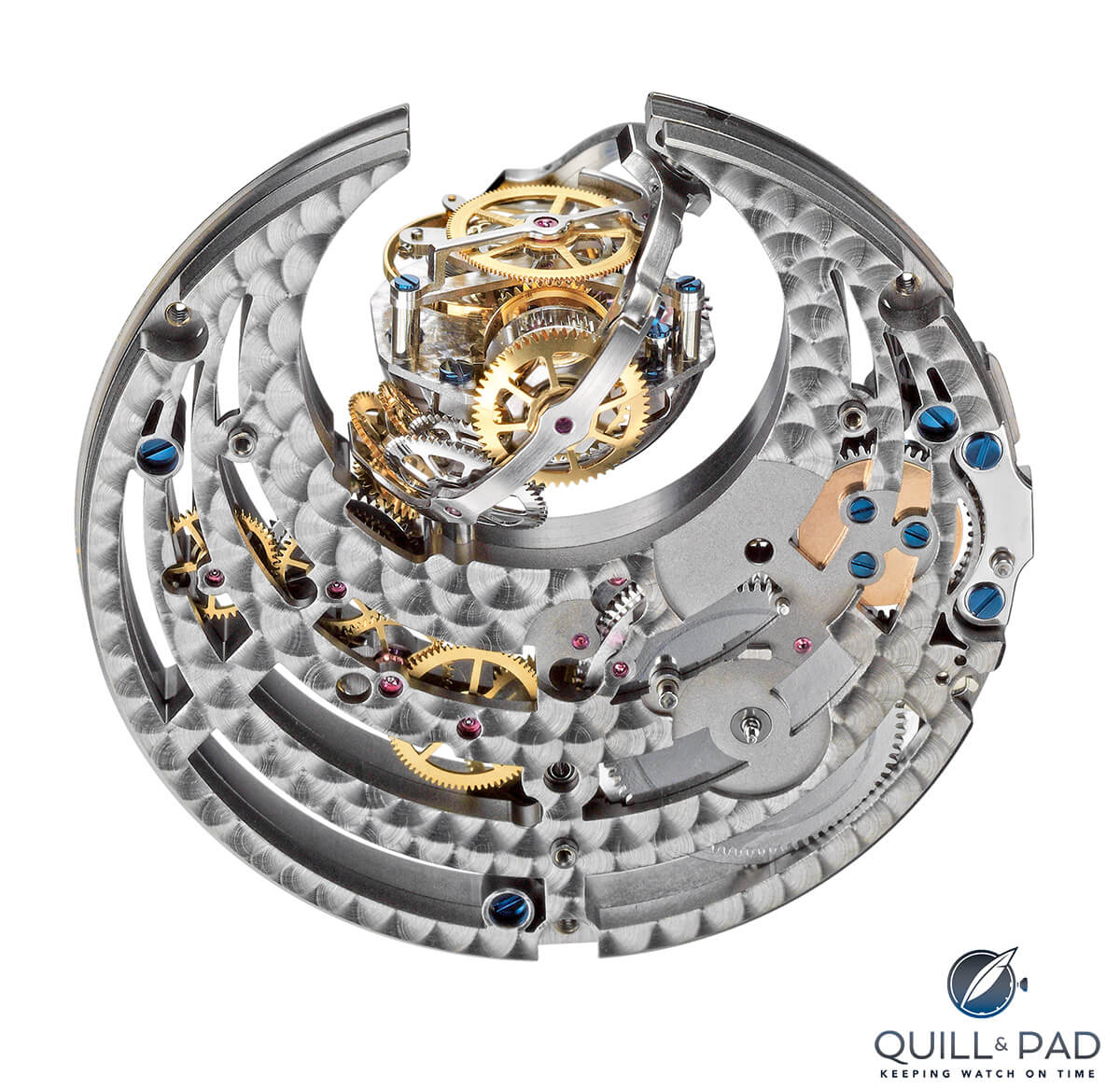
The Zero G gravity module from the movement of the Zenith Academy Christoph Colomb
I would also add a modern pilot’s watch to the line: one with altimeter, one with a (proper) GMT. I would bring back the Striking Tenth and come up with some new ways to harness that 5 Hz goodness on the dial. I would drop a pulsometer or telemeter onto the dial once in a while. And I would pull Ludwig Oechslin’s simplified and gorgeous annual calendar out of the El Primero and drop it into an Elite, where it belongs.

Zenith El Primero 410
JS: Next, historically inspired pieces are awesome, but we shouldn’t assume that is all people want or that only “iconic” pieces should be recreated. I would take some risks, find unique combinations, but do it with purpose.
RS: The Heritage line, which is basically the home of the pilot’s watch at Zenith, would become the Pilot line if I were CEO. Instead of putting all the heritage pieces into one separate bucket, there needs to be a clear connection to the past throughout each of the five Zenith lines. Get the archives out and make sure each line has something that pretty much replicates an old gem.

The Zenith Heritage Pilot Type 20 Extra Special, a 45 mm bronze-encased heritage-inspired wristwatch, on the wrist of Kiss drummer Eric Singer
JS: I would urge the designers and engineers to find a Zenith “core” and use it as a driving force behind all the watches. It might make me unpopular, but marketing should hardly ever influence design. Good designers look at trends to see where the market is going not in an attempt to copy but to differentiate; they also create trends and step outside of the obvious mainstream path.
Apple clearly doesn’t ask what the average consumer wants as it pushes boundaries and determines its own future; it gives consumers what it believes they need. Let marketing focus on selling what the designers and engineers know is good. Enthusiasts will follow, otherwise without a coherent direction they might stray – as can be seen with other brands right now (IWC in particular).
Zenith should design and develop with purpose and focus, and hopefully it would pay off even in slower economic times.
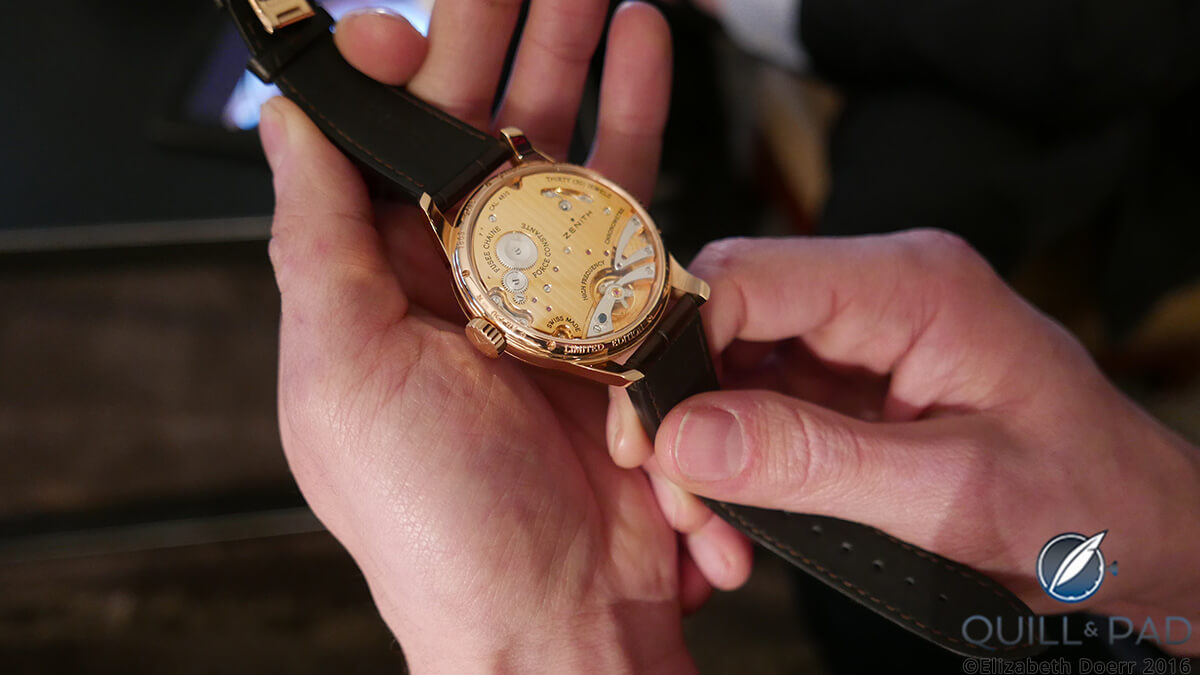
A beautiful rear view of the Zenith Academy Georges Favre Jacot, the name of which is a nod to the brand’s long history
ED: Joshua, you are speaking from my heart: I have always said that brands with distinct golden threads tracing a brand’s core from the beginning helps it to remain cohesive even in troubling economic times because it aids consumers in understanding that it maintains stability and a truthfulness to itself.
The brands that are doing best right now in this economically uncertain era are those that remain true to themselves without changing course too much. Audemars Piguet and Richard Mille are two great examples of this.
GG: A more radical, but still plausible, strategy would be to exit the timepiece business completely and simply supply the El Primero movement to a number of other watch companies as Zenith once did with Rolex. From a corporate parent portfolio view, it might make sense to take one brand (Zenith) out of the mix as GM did with Oldsmobile and Saturn, for instance, while still extracting value from the El Primero strategic asset.
IS: I’m with you on that “third-party supplier” strategy, Gary.
Partnerships
JM: If I were the new CEO of Zenith, the first thing I would do would be to cool it with the special editions for extremely limited audiences. I don’t believe it presents a cohesive image of the brand and it dilutes focus and resources (however small) that could be better used creating a solid model base.
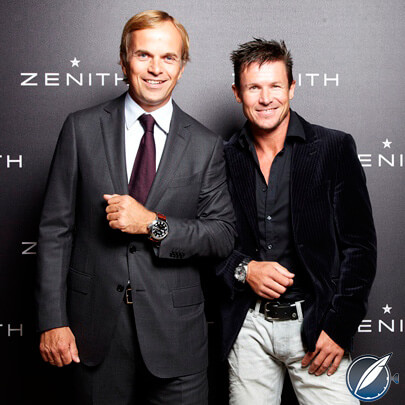
Former Zenith CEO Jean-Frédéric Dufour with superstar BASE jumper Felix Baumgartner in 2012; Dufour successfully established this powerful alliance with the popular athlete
The same goes for celebrity ambassadors: they look shiny, but unless they are athletes or drivers who can wear the performance watches, they dilute Zenith’s message of strong horology and sports heritage. It seems a bit out of place for Zenith to me.
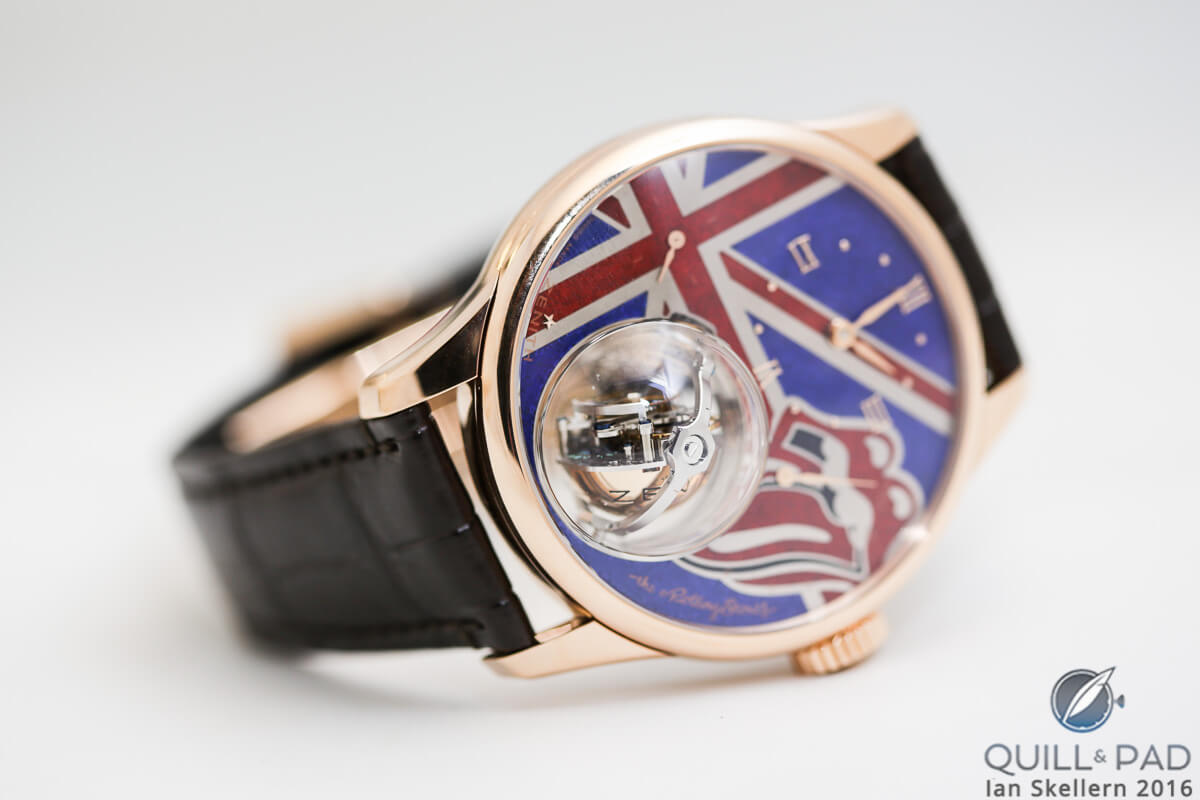
Zenith Christophe Colomb Tribute to The Rolling Stones
ED: The Rolling Stones “partnership” was nothing more than the Stones’ management selling their logo to Zenith for use on watches. Aside from that, I didn’t understand this very well: Zenith already hits the Stones’ core fan base in terms of age. While the Stones can truthfully be said to be a multigenerational band, it’s not the Millenials we are talking about among those generations – which is the strategy that Biver is following with TAG Heuer and Hublot: hitting the up-and-coming generation of watch consumers.
To illustrate my confusion in terms of this strategy: the Zenith Christophe Colomb Tribute to the Rolling Stones at 220,000 Swiss francs is hardly aimed at the typical Rolling Stones fan or the Millenial. So who is supposed to be the target group for this timepiece?
While the Zenith Chronomaster 1969 Tribute to the Rolling Stones is more likely to produce a few more sales at $14,200, the message remains confused – even for me, a self-professed rock fan. So as CEO, I would define this strategy much more clearly so I could send messages to my intended group of consumers in a more clear-cut manner understood by everyone.
WMMT: I would also stop partnerships with English brands altogether as obviously neither the Rolling Stones nor the Range Rover partnerships have visibly increased sales.
If I were CEO of Zenith I would do a partnership with Kiss instead, whose fans are ready to pay big bucks for any item at all with Kiss’s logo on it. I would make a special limited collection with four different watches, each with the likeness of a Kiss member on the dial – remember the four solo albums of 1978 where this strategy worked so well? – and owners of the full set would be invited to drink tea with Gene Simmons, who would actually show up to a brand-organized meet and greet for its VIPs.
RS: (still laughing) If I were CEO, I would cut 66 percent of the spend on ambassadors, brand partnerships, and special edition watches. The savings would be split between research and development and more traditional advertising, including the best digital publications (you know, directly telling people – Zenith’s core consumers – about its watches?).
[For more discussion on celebrity ambassadors, see Celebrity Ambassadors: Good Marketing Or Terrible Waste?]
Every meeting at Zenith needs to start by answering the question: are we talking about watches?

Zenith Elite
As CEO . . .
WMMT: If I were CEO of Zenith the first thing I would do would be to negotiate a mega golden parachute that would put David Zaslav to shame.
The second thing would be to stop sponsoring Zenith forums online as no one needs to read the comments of someone who bought a second-hand Zenith 15 years ago and who keeps complaining how bad the new designs are.
IS: I’d be ensuring that recruitment headhunters had my CV in their “actively looking” files and were well aware that I was still in the market and looking for a more stable position – one outside the watch industry!
ED: Like Thierry Nataf, who went to champagne after watches, Ian?
IS: I thought he was training birds of prey?
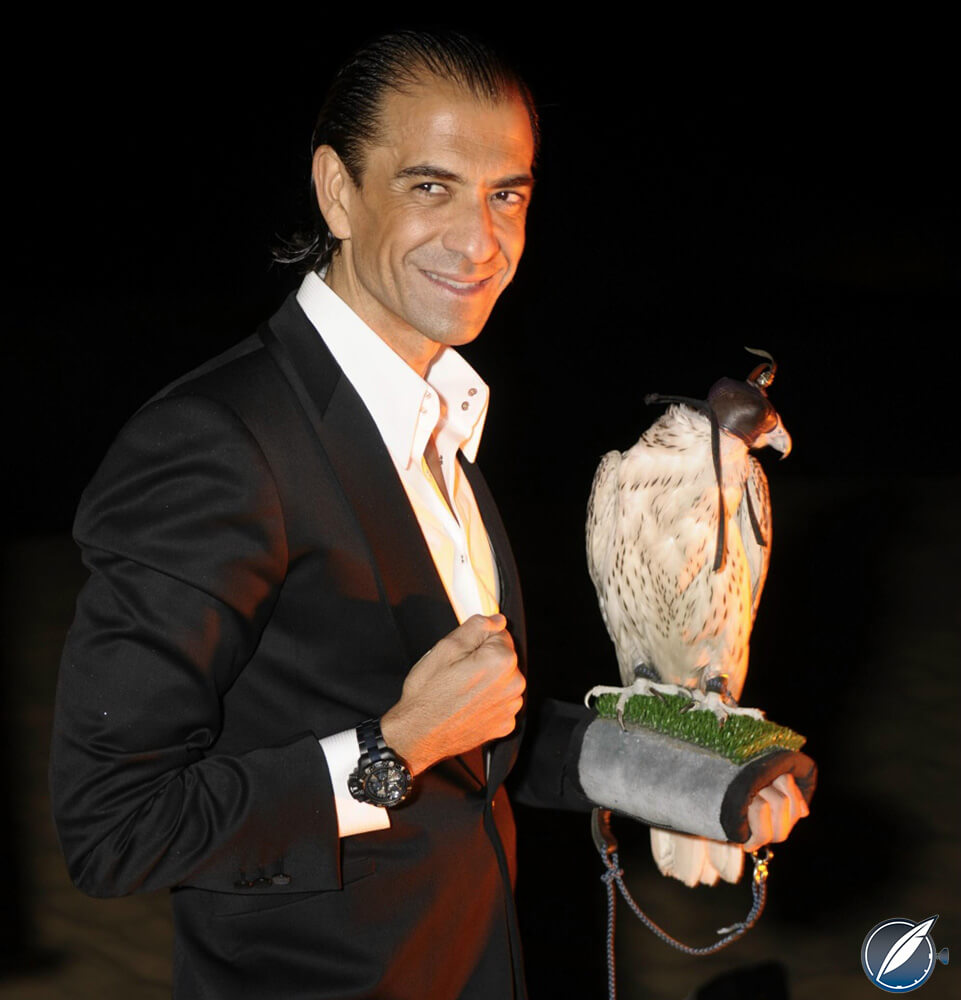
Former Zenith CEO Thierry Nataf with a hooded friend on one wrist and a Defy Xtreme Zero-G on the other
WMMT: If I became CEO of Zenith I wouldn’t resign! Yup, you read that correctly: this brand needs some kind of stability, and continuously changing CEOs is a bad idea as each new CEO wants to break from what his predecessor did, so you find yourself with a brand that keeps changing direction and you end up with collectors who at one point decide to stop following you and turn to Patek Philippe for a pilot’s watch.
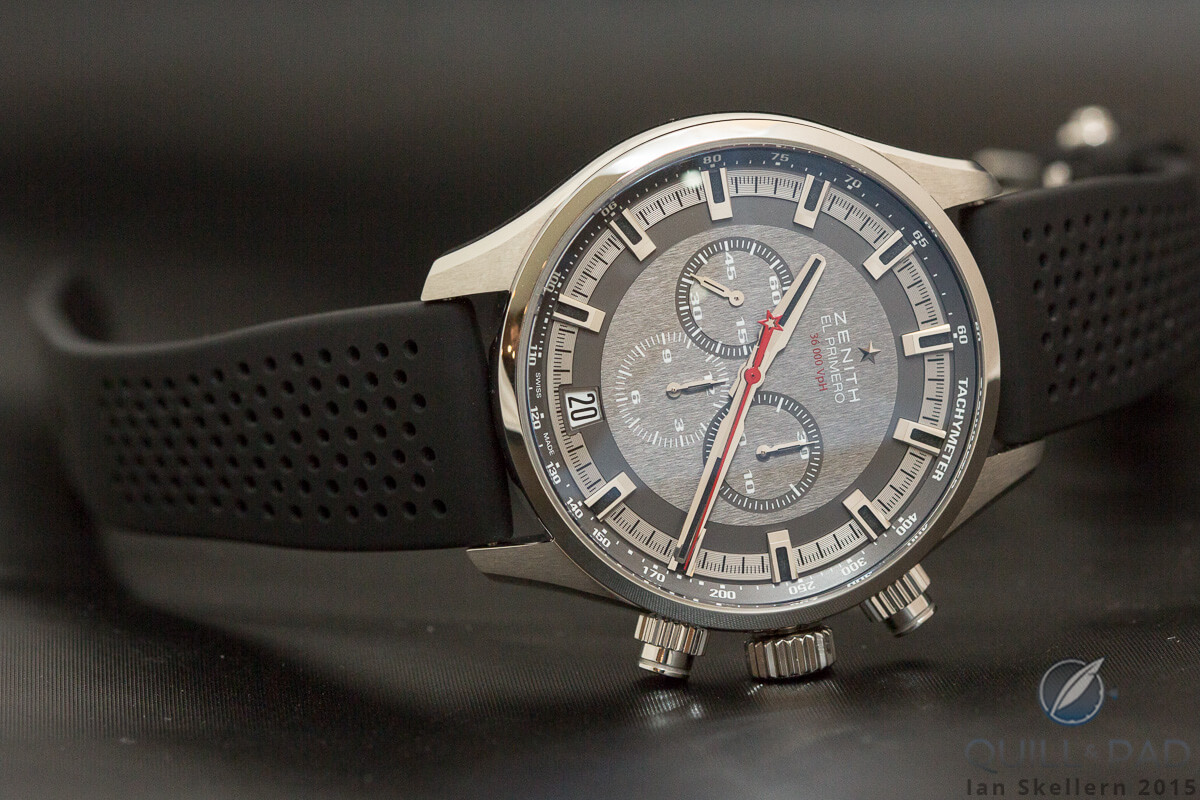
Zenith El Primero Sport
IS: On a more positive note, the announcement that Jean-Claude Biver has taken the reins as CEO instead of me changes my pessimism to optimism because if there is one man who can work miracles with watch brands it’s JCB.
The storm clouds have parted, and rays of sunshine stream from the heaven . . . on Zenith.
Other brands beware!
Let us know what you would do as the new CEO of Zenith to #makezenithgreatagain in the comments below.
Trackbacks & Pingbacks
-
[…] Occasionally a brand gets lost, like Zenith under former CEO Thierry Nataf, who took the brand from its original DNA space for a fling with the Russian market that didn’t last (see What Would You Do If you Were The New CEO Of Zenith? This Is What We Would Do . . .). […]
-
[…] This is pretty much what happened with Zenith under its first LVMH CEO (see What Would You Do If You Were The New CEO Of Zenith? This Is What We Would Do . . .). […]
-
[…] place to be,” Jean-Frédéric Dufour, now CEO of Rolex, told me back in 2012 when he was still CEO of Zenith. “It is the world’s most important and oldest trade show in the watchmaking […]
-
[…] […]
Leave a Reply
Want to join the discussion?Feel free to contribute!





















































Clean up the channel, reduce the number of grey market dealers and they have to be more vertically integrated, this includes retailer support that is traditional in the consumer electronics industry where the product isn’t sold until the retailers sells it to the customer. Right now it’s more like the Multil level marketing where you have to buy a certain level of inventory to keep your dealership but they offer no help on how to sell through. Offer stock rotation support, cost / price protection and in return they will report what is selling. This does 2 things, they no longer have a pressure to offload to grey markets and the manufacturer gets a better signal to what products are selling.
Zenith at its core is a “hi-beat” manufacture, to steal Grand Seiko’s term. Yes the company was a century old before the El Primero came along but in a overflowing watch market full of “me too” designs the 36000 bph movement is about the only (almost) unique thing Zenth has to offer. This, then, should be the foundation for the ‘new’ Zenith. From that should be built fewer lines (Elite, Pilot, El Primero), the first two featuring 36000 bph non-chronograph movements. So the answer to the question “what is Zenith?” would be “a brand which makes only high frequency mechanical watches.”
Great point. They could steal some of that mikro tech from TAG while they play catch up too!
Dear Lord, am I the only one who sees what Zenith has been sleeping through since 1968:
EL PRIMERO, “THE FIRST”
Nobody talks about the history of El Primero, the first automatic chronograph.
Write that on every window in the house, and waive the flag.
Best name for a product in the business, and nobody mentions it at all.
Jean-Claude, you have my number. 🙂
Hey Mike! Well, at least I mentioned the step-out strategy idea of shrinking the entire business to become a supplier of the El Primero movement to others — an “Intel Inside” play that eliminates all of the other costs of the business, wholesale and retail distribution, design, advertising, finished goods inventory, and yet leverages the one big strategic asset of the company, which to me is the El Primero…
I do wonder if there are certain legal reasons they have not been able to shout this from the rooftops Mike 😉
The El Primero was not the first automatic chronograph.
The first automatic chronograph came from Seiko.
Any suggestions are most welcome if you send me them per mail:
[email protected]
or
[email protected]
Thank you in advance for any recommandation
Jean Claude Biver
If you get stuck Mr. Biver, you know who to call 🙂
Hmmm…
Stop selling dial space as a moving billboard, for rock bands, cars and cigars. Let Hublot do that if you want, but Zenith has more class.
Get rid of the Academy line altogether. Take the remaining three lines and cull them down to 5-6 pieces each. Stop trying so hard to be everything to everyone. Be more like Rolex. Seriously.
Zenith needs to be the star (get it?) of LVMH.
Also, your description of the El Primero 410 pictured above is incorrect, it is not a Winsor annual calendar. Although if the 410 had the annual calendar, that would be pretty cool.
Thanks for the heads up on that caption, I’ve fixed it.
1. Expand & Upgrade Distribution
Clean up – select – invest
2. Harness Online Presence
Clean up – select – invest – customer touch point needs ONE consistent message
Kill not-own operated online sales – control SoMe
3. Improve shopping experience
Clean up – select – invest
4. Establish Concept Stores
Invest in brand doors at selective locations
5. Limit Production
Kill grey market
6. Kill your darlings
Look at your sell through
Sadly, anyone appointed CEO under the long shadow of JC Biver will not have the chance to really stir things up. Biver’s larger than life personality has I assumed has an equally large ego. Whomever he appoints will be his puppet. Zenith might as well make Justin Bieber CEO. At least then they would save money on the monogram towels in the wash room.⌚
Lol… Biver is a genius… He’s a reviver, Nataf was too flamboyant yet passionate but he had misplaced passion which wasn’t for the ZENITH DNA. Zenith needs careful design restructuring of their iconic models, desperation has caused their latest offering to resemble the Daytona.
Good discussion. Seems not everyone agrees on how to turn Zenith around.
Unsolicited advice:
1) Proper synergy between the movements, cases and dials. El Primero needs a large series cousin.
2) Stop looking backwards to 1969 and backwards to 2012. Marketplace is saturated with retro and heritage pieces.
If you were given a choice between being given great wisdom or great wealth, which would you choose?
Great wealth.
Dear Elisabeth ,
Hope you are doing well.
I found your 2017 January Quill & Pad article mentioning my name and contribution and the debate you all have.
I was surprised and disappointed reading how you analyze my 8 years as President & CEO of ZENITH (2001-2009), and the way you are talking about my contribution to the Brand. At least, you could have contacted me to ask for my comments.
We are in 2017, and it has been 8 years since I’ve left this company. I would love to give you an interview and explain to you what was done during those years by my team and myself with the approbation of LVMH management board. Believe me you do not stay at the helm of the LVMH house for 8 years – and 11 years with LVMH – if your results and your strategy are not prooving right.
Looking forward to hear from you,
Best regards,
Thierry
Thierry Nataf
President & CEO
THE LUXURY CONSULTING COMPANY
F Cell: + 33 6 08 49 16 62
Office: + 33 1 47 04 31 42
Skype: thierry.nataf1
Wechat: ThierryNataf
Email:[email protected]
http://linkedin.com/in/thierrynataf
The Luxury Consulting Company
Web Site: http://theluxuryconsultingcompany.com
The Luxury Blog: http://theluxuryconsultingcompany.com/the-luxury-blog
Instagram: http://www.instagram.com/theluxuryconsultingcompany
THE LUXURY CONSULTING COMPANY is a global international Strategic & Business Consulting Firm fully dedicated to The Luxury Industry.
INDUSTRY : Fashion & Accessories, Perfumes & Cosmetics, Watches & Jewelry, Homeware & Interior Design, Wines & Spirits, Luxury Retail , Media, Real Estates, Luxury Hotels & Resorts & Cruises and Art are among our major industry practices.
SERVICES: Strategy, Brand, Marketing & Sales, Creativity & Innovation, Products & Services, Communication, Globalization, Digital Business and Operations are among our major service practices.
INTERNATIONAL: As a global international Management Consulting Company, we cover Europe, Americas, Asia Pacific & Middle East, with offices and correspondents in Paris , London & Moscow for West & East Europe, New York for North & South America, Shanghai & Honk Kong for Asia Pacific and Dubai for the Middle East.
M&A, EQUITY FUNDS & CAPITAL VENTURES: We do manage Mergers & Acquisitions, collaborate with the M&A, Best Equity Funds & Capital Venture Firms and Top 10 World Investment Banking & Consulting Firms.
Love you Thierry
A fan
Thierry, you were the BEST thing that ever happened to Zenith…You brought it up to JLC quality. Thank you
I would make Motors for old cars that go to little city’s like Alamogordo that only go fifty miles per hour . Charge able of course with just two hours of drive time it’s not to big here . If that makes sense then let it make you dollars . Nice company and thanks for asking .